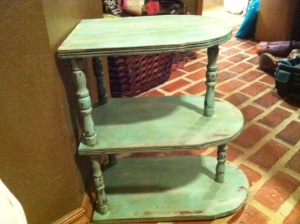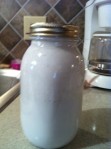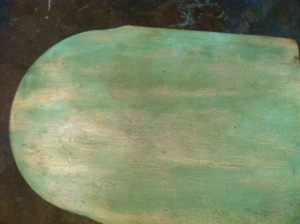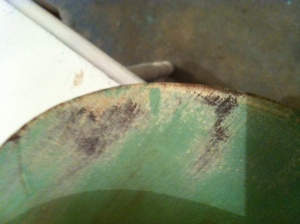Well, I tried it! After reading so much about milk paint and how it finishes out so nice, I HAD to give it a go. I bought a package of white milk paint from WoodCraft (on May) in OKC. I will say that next time, I will probably order online from Homestead as WoodCraft was almost too much of a “man’s man” place and they kept telling me I wanted something else…an almost $20 MORE something else. Other than that, I was excited to get started. So, here is the process I used from start to finish.
Step 1: Prepping your piece
Milk Paint will adhere to porous surfaces without sanding or priming, however, for less porous surfaces, experts recommend you use a milk paint bonding agent. You can normally buy this where ever you buy milk paint.
My step 1 was priming the piece I was painting. This table was a nasty, nasty Texas burnt orange color…and you know how us Oakies feel about Texas orange…so I primed it with a coat of Killz first to ensure that color did not come through. I did not invest in a bonding agent since the table I was working on was so scuffed up and I really wanted to keep that look, versus sanding it out and making it smooth.
Step 2: Mixing the Milk Paint
This was the un-fun part. Milk Paint comes in two varieties (or two that I know of): liquid or powder form. I chose to use the powder form for no other reason other than it was less expensive and I wanted to make sure I liked it before making a larger investment. With the powder milk paint, you mix equal parts of the powder with water. I knew I was going to use the full amount, so I mixed 1.5 cups (the entire package of powder) with 1.5 cups of water. You can mix this in any amount, in any container. I chose to use an old mason jar incase I didn’t get to use it all at one time, it would be inside an air-tight container.
Now, here is the biggest down fall I found with this Milk Paint…it was HARD, and I mean HARD in all capitals and a few exclamation points (and a few unlady like words I must admit), to mix. A paint stick was not cutting it, a spoon did not cut it, so finally I robbed my utensil drawer of a whisk and went to town inside that mason jar. It honestly took a lot of whisking, but I did finally get it to a desirable consistency…or so I thought.
Step 3: Applying the milk paint
Milk paint can be applied with a brush, roller, or sprayer. Most professionals recommend using a sprayer to apply milk paint as it gives it the smoothest finish. Since I was just trying it out on one piece, I did not want to mess with the sprayer. I first tried brushing it on, really just playing with it to get a feel for its texture, etc. It is very thin and milky…so it showed every brush stroke and I quickly put the brush away. Next I tried the foam roller and this did give better coverage, however, after 2 coats, I could still see through the milk paint to the dark wood underneath. I also noticed as I rolled, that the paint was still clumpy. I mixed and mixed this paint, but it was still showing little clumps randomly. That was a little frustrating, but not a deal breaker.
Step 4: Top Coat
After 3 coats of milk paint, I just did not like how the dark wood was appearing, almost streaky, from underneath the paint. So I do what all us DIYers do, I decided to experiment and prayed for the best! 🙂 I took 1/2 cup of CeCe Caldwell’s Santa Fe turquoise paint and added it to 1/2 cup of the milk paint. I honestly have no idea if this is “ok” or if it is a little unknown “no-no” but I did it and I love how it turned out!! I applied one, thin, top coat of this. I let it cure about 6 hours (it did not take that long to dry, I just began working on other projects). You can see how thin the top coat is…now this is actually shown after I distressed it, but hopefully you can make out how light the turquoise is.
Step 5: Finishing
To finish out this piece, I took a 220 grit sanding block and really distressed the turquoise out. I was a bit more careful around the outsides of the dark wood spots…with milk paint, known for its ease and classic distressed look, I wanted each spot to look as though it was slowly worn off over time, pulling away from the worn spots. An example is shown below:
Once I was happy with the distressing, I applied my usual dark wax mix (CeCe Caldwell’s clear wax tinted with Hershey brown) over the piece. I did NOT apply the clear wax by itself before or after this…mainly because it was such a small piece, and because I am comfortable with the dark wax (so not worried as to use too much or about streaking it).
Here is the finished product:
 Overall, I am very happy with how the project turned out. I really wanted to do the whole piece in milk paint, but sometimes you just have to go with it and be creative as you go! As for milk paint, I am glad I tried it and I do have a dresser that I am ready to tackle next…but this time I am ordering my milk paint from Homestead, mainly because they have MANY, MANY more colors to choose from and because I am hoping their milk paint is easier to mix. Please leave any suggestions you have for milk paint!!! I would love to read about your experiences with it. Also, be on the look out for Ms. Mustard Seed’s new line of milk paint…she is the queen of everything paint, and I am confident anything with her name on it will be great!
Overall, I am very happy with how the project turned out. I really wanted to do the whole piece in milk paint, but sometimes you just have to go with it and be creative as you go! As for milk paint, I am glad I tried it and I do have a dresser that I am ready to tackle next…but this time I am ordering my milk paint from Homestead, mainly because they have MANY, MANY more colors to choose from and because I am hoping their milk paint is easier to mix. Please leave any suggestions you have for milk paint!!! I would love to read about your experiences with it. Also, be on the look out for Ms. Mustard Seed’s new line of milk paint…she is the queen of everything paint, and I am confident anything with her name on it will be great!
Happy Painting!



Leave a comment